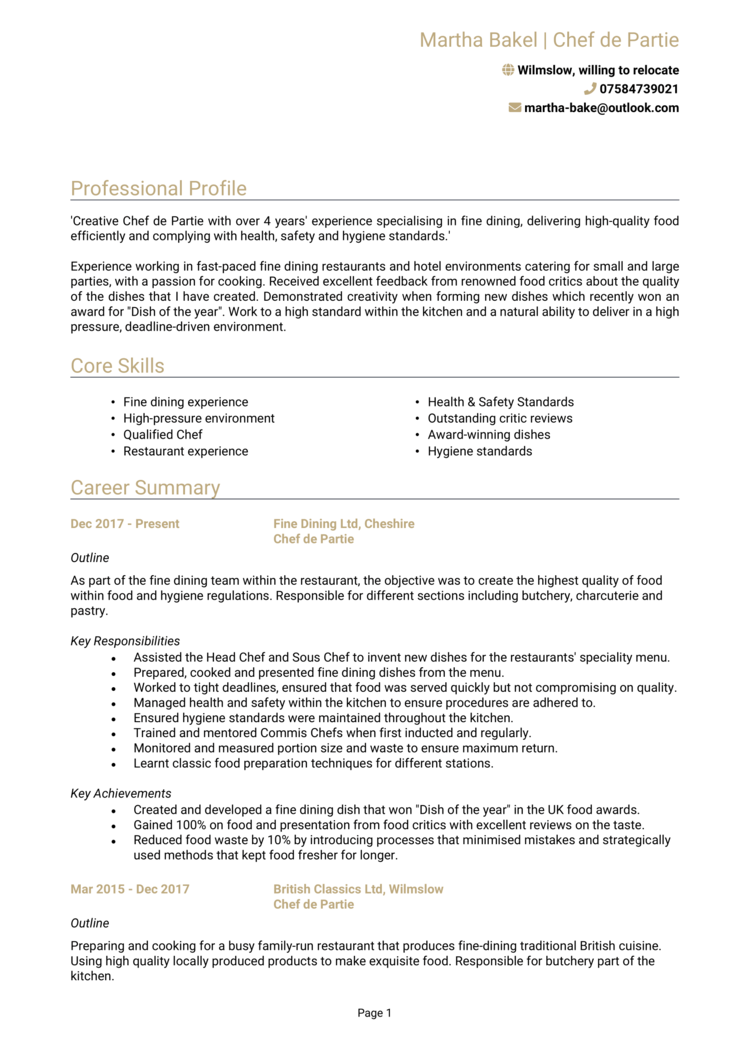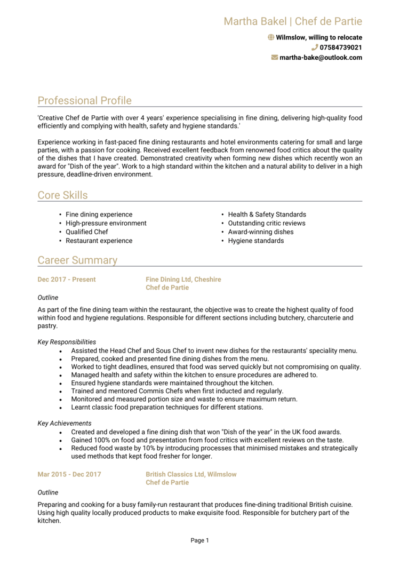You can plate up under pressure like it’s second nature, but you’ll need a CV that showcases more than just your knife skills – it should highlight your reliability and experience behind the pass.
This guide and its Chef de Partie example CVs will help you put together a well-seasoned application that proves you’re ready to take the heat and deliver at a professional level.
Chef de Partie CV

Line Cook CV

How to write your Chef de Partie CV
Discover how to craft a winning Chef de Partie CV that lands interviews with this simple step-by-step guide.
Kitchens are fast, high-pressure environments – and recruiters are looking for chefs who can thrive under those conditions. Your CV should reflect your ability to work as part of a busy brigade.
This guide will take you through how to structure your experience and training so that your CV gets noticed and compels hiring managers.
What’s the right way to structure and format your Chef de Partie CV?


A good kitchen runs on structure, and your CV should too. It needs to give employers a clear overview of your culinary background: the sections you’ve worked on and how you’ve contributed to smooth service. Recruiters should be able to pick out the key details without struggling through structural mistakes.
Here’s the layout to follow:
- Name and contact details – personal details go right at the top so employers can get in touch easily. No need for a photo.
- Profile – A short paragraph summarising your kitchen experience, specialisms, and strengths.
- Core skills – Use bullet points to highlight key abilities, such as plating, prep, and service support.
- Work experience – Start with your most recent role and work backwards. Focus on the kitchens, menus, and techniques you’ve worked with.
- Education & certifications – Include your chef training, food safety certifications, and any additional qualifications like a degree.
- Additional info – Optionally include languages, awards, or hobbies if relevant.
To keep your CV professional and easy to read, use a clean, readable font, separate your sections clearly, break down detail with bullet points, and keep the document to a maximum of two pages in length. A clean and clear format will keep the focus on your expertise, rather than visual errors.
How to create a Chef de Partie CV profile


Your CV profile is your chance to introduce yourself as a dependable, experienced kitchen professional. It should give recruiters a flavour of your background, your strongest attributes, and what you’re looking for next: you want to highlight the genuine, positive impact you’ll bring to any kitchen you enter.
Chef de Partie CV profile examples
Profile 1
Skilled Chef de Partie with five years of experience in high-end restaurants and hotel kitchens, specialising in grill and sauté sections. Proficient in preparing a variety of dishes to exacting standards, managing junior kitchen staff, and maintaining cleanliness and safety. Adept at working under pressure during busy service periods while maintaining consistent quality and presentation.
Profile 2
Experienced Chef de Partie with four years of culinary experience in fast-paced bistros and banqueting settings. Skilled in managing prep stations, overseeing mise en place, and supporting smooth kitchen operations. Familiar with stock control, portioning, and dietary requirements. Passionate about modern European cuisine and delivering high standards of food quality.
Profile 3
Dedicated Chef de Partie with six years of experience across gastropubs and casual fine dining venues. Strong background in meat and sauce sections, plating techniques, and kitchen organisation. Known for teamwork, attention to detail, and consistency under pressure. Committed to upholding food safety regulations and contributing to creative menu development.
Details to put in your Chef de Partie CV profile
Here’s some helpful tips on what to include:
- Experience level – Mention the types of kitchens you’ve worked in and how long you’ve been at CDP level.
- Station specialisms – Highlight whether you’ve led the grill, fish, garnish, larder, or pastry section.
- Strengths – Emphasise qualities like calm under pressure, speed, accuracy, or leadership in service.
- Career goals – Briefly mention your next steps – e.g. gaining more responsibility or moving into a senior CDP or Sous Chef role.
Presenting your core skills


The core skills section should present the tools of your trade – everything that makes you effective on your station and valuable to your team. It’s not just about cooking – it’s about communication and consistency.
Tailor the skills for your CV to the job description and kitchen style you’re applying to, keeping them relevant and easy to scan. Make sure these reflect both your technical ability and how you function on a team under pressure.
Essential skills that recruiters look for in a Chef de Partie CV
- Section Supervision – Managing a specific section of the kitchen (e.g. grill, pastry, sauce) and ensuring smooth operation during service.
- Food Preparation and Cooking – Preparing high-quality dishes in line with recipes, presentation standards, and portion sizes.
- Team Collaboration – Working closely with sous chefs, commis chefs, and other brigade members to maintain kitchen flow.
- Ingredient Management – Ensuring mise en place is completed, ingredients are fresh, and stock levels are maintained.
- Quality Control – Checking taste, texture, and presentation of dishes before they leave the kitchen.
- Health and Safety Compliance – Adhering to food hygiene regulations and maintaining a clean, safe work environment.
- Training and Mentorship – Guiding junior kitchen staff, helping them develop skills and understand kitchen procedures.
- Time Management – Coordinating cooking times across multiple dishes to ensure timely service during busy periods.
- Menu Development Support – Assisting in the creation and testing of new menu items under the head chef’s guidance.
- Kitchen Equipment Use – Operating and maintaining tools and machinery relevant to the assigned kitchen section.
How to highlight work experience


This is where you show not just what you’ve done – but how well you’ve done it, and in what kind of kitchen. From prep and plating to managing junior staff and keeping cool during a busy Saturday night, your work experience section should show your contribution to smooth, high-quality service.
List your roles from most recent to earliest. Focus on the scale and style of the kitchen, your responsibilities on the pass, and how you contributed to the team’s success.
How to make your past experience easy to read for employers

- Outline – State the restaurant, hotel, or kitchen, and what kind of establishment it is (fine dining, brasserie, hotel, etc.).
- Responsibilities – List your key duties using action verbs like “prepared,” “led,” “garnished,” or “maintained.”
- Achievements – Highlight accomplishments such as reduced waste, positive reviews, new dishes developed, or improved prep efficiency.
Example job entries for a Chef de Partie
Chef de Partie | The Elm House Brasserie
Outline
Prepared and presented dishes to a high standard in a busy modern British kitchen, taking ownership of the grill section and supervising junior staff during service.
Responsibilities
- Managed mise en place and food preparation for the grill section, including steaks, seafood, and sides.
- Worked closely with sous and head chefs to maintain service speed and consistency.
- Ensured food safety, hygiene, and allergen procedures were strictly followed.
- Trained commis chefs and new starters on section responsibilities and prep routines.
- Contributed to specials board ideas and seasonal menu planning.
Achievements
- Helped reduce food waste by 20% through improved portion control and stock rotation.
- Recognised for consistency in cooking and plating during peak service hours.
- Supported a successful local food award submission through quality execution.
Chef de Partie | Langmere Hotel and Spa
Outline
Led the sauce section in a 4-star hotel kitchen serving à la carte, afternoon tea, and private events, ensuring high levels of food quality and presentation.
Responsibilities
- Led the sauce section in a 4-star hotel kitchen serving à la carte, afternoon tea, and private events, ensuring high levels of food quality and presentation.
Achievements
- Consistently met food hygiene targets with no non-conformances during audits.
- Reduced prep time by 15% through improved station layout and prep list efficiency.
- Received positive guest feedback on sauce pairings and dish presentation.
Chef de Partie | Riverstone Kitchen and Bar
Outline
Oversaw daily service for the sauté section in a busy riverside restaurant, preparing modern European dishes and ensuring service ran efficiently.
Responsibilities
- Executed dishes during lunch and dinner service, working independently and as part of a brigade.
- Maintained accurate labelling and stock levels for section ingredients.
- Worked with the sous chef to develop seasonal dishes and refine existing menu items.
- Followed HACCP procedures and supported kitchen cleaning schedules.
- Assisted in managing kitchen deliveries and storage procedures.
Achievements
- Promoted from commis to Chef de Partie within 12 months of joining.
- Contributed to improved review ratings by ensuring consistent food quality.
- Recognised for creativity in vegetarian and vegan dish development.
Education and qualifications


Formal chef training and up-to-date safety certifications can make a big difference to employers, so be sure to present this section clearly. Start with your most recent or highest qualification and include the name of the course and training provider.
Generally speaking, recruiters value experience more highly, so your education section should be concise and keep the focus on more important bits.
Qualifications recruiters look for in a Chef de Partie
- NVQ Level 2 or 3 in Professional Cookery – Standard vocational qualification for chefs.
- City & Guilds Diploma in Culinary Arts – A solid foundation in technique and kitchen skills.
- Level 2 Food Safety and Hygiene Certificate – A must-have for working in any professional kitchen.
- Allergen Awareness Training – Increasingly essential in hospitality environments.
- COSHH or HACCP Certification – Important for safe handling and storage of ingredients and chemicals.





